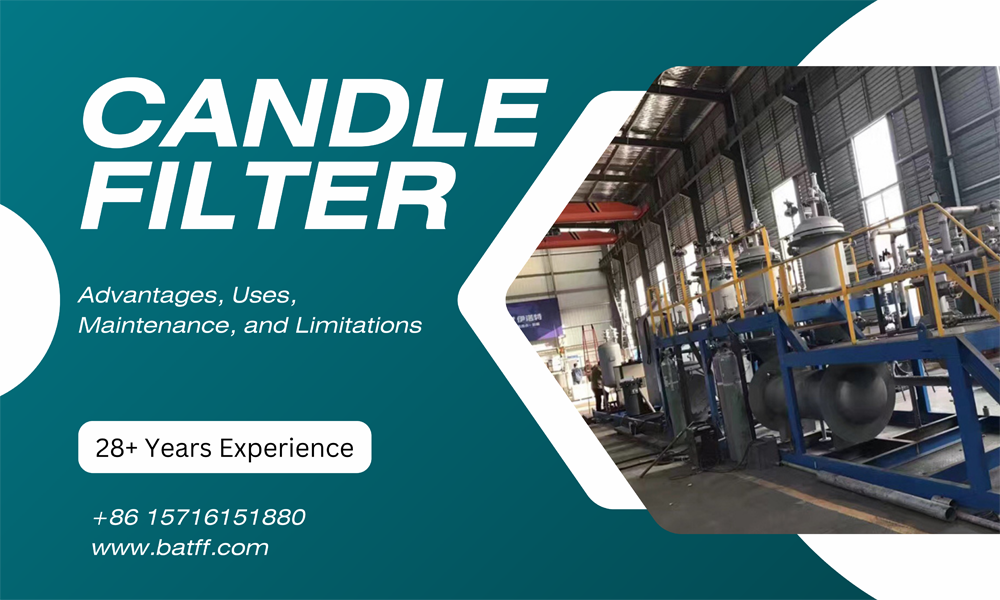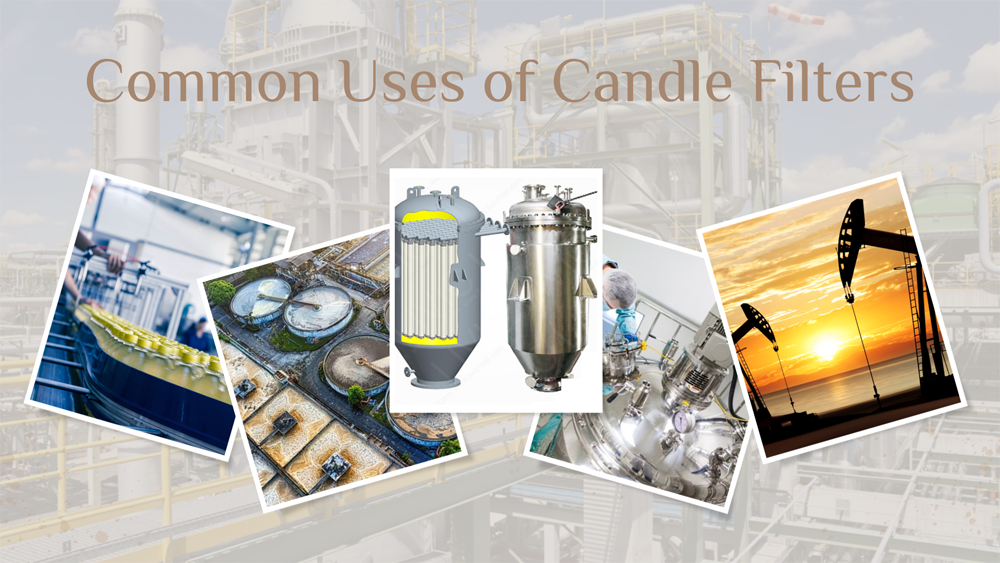
In the world of filtration technology, candle filters stand out due to their distinctive design and superior functionality. Originally developed to meet the rigorous demands of fluid purification and particulate removal, these filters have found widespread application across various industries. Candle filters, named for their long, slender shape reminiscent of a candle, offer a unique blend of efficiency and reliability in filtering liquids and gases.
Whether you are involved in industrial manufacturing, environmental engineering, or simply interested in advanced filtration methods for home use, understanding how candle filters work, their benefits, and their limitations is crucial. From enhancing water purity to maintaining clean air standards, the roles of candle filters are both diverse and impactful.
As we delve into the specifics of candle filters, we will explore their advantages, common applications, maintenance requirements, and the inherent limitations that users should be aware of. This comprehensive overview aims to equip you with the knowledge needed to make informed decisions about using and maintaining candle filters effectively.
Candle filters are highly favored in industries where precision and efficiency in filtration are paramount. Here’s a deeper look into the core advantages that make these filters an essential component in numerous applications:
1.High Filtration Efficiency: Candle filters are designed to capture a wide range of particle sizes with high accuracy. They utilize a deep bed filtration mechanism, which enhances their ability to trap and retain particles. This makes them particularly effective in applications requiring high purity outputs, such as pharmaceutical manufacturing and fine chemical processes.
2.Cost-Efficiency: Due to their design and materials, candle filters typically have a long service life. They are made from durable materials like stainless steel or ceramic, which can withstand harsh conditions and corrosive substances. The longevity and durability of candle filters reduce the need for frequent replacements, thus lowering the overall operational costs.
3.Low Maintenance Requirements: Candle filters require minimal maintenance. Their structure allows for easy cleaning and backwashing, which can be done without disassembling the entire system. This ease of maintenance helps in keeping downtime to a minimum and operations running smoothly.
4.Environmental Impact: Candle filters contribute to environmental protection by reducing waste. Their efficiency in filtering out contaminants means less waste is generated, and fewer chemicals are used in the process. Additionally, the reusability of these filters lessens the environmental burden of disposal and replacement.
5.Versatility: Candle filters are versatile in their application. They can be used for a variety of liquids and gases, ranging from water to chemicals, and from fine particles to coarse sediments. This versatility makes them suitable for a broad range of industries, including water treatment, oil and gas, food and beverage, and more.
Candle filters are not only versatile in the materials they can handle but also in their applications across various industries. This section explores some of the key areas where candle filters are extensively used, demonstrating their importance and versatility.

Water Treatment: Candle filters play a crucial role in the water treatment process, both for municipal and industrial purposes. They are used for removing sediments, microorganisms, and chemical impurities, ensuring the water is safe for consumption or further industrial use.
Chemical Industry: In the chemical industry, candle filters are used to purify raw inputs and final products. They remove impurities that could affect the quality and stability of chemical compounds. Their high precision ensures that even the smallest particulate contaminants are removed, which is crucial for maintaining strict quality standards.
Pharmaceuticals: The pharmaceutical industry requires extremely high levels of purity in both raw materials and finished products. Candle filters are used to ensure that preparations are free from particulates and bacterial contamination, which could otherwise compromise the safety and efficacy of pharmaceutical products.
Food and Beverage: Candle filters are employed in the food and beverage industry to clarify liquids such as oils, wines, and syrups. They help in removing fine particulates that can affect the appearance, taste, and shelf life of food products.
Oil and Gas: In the oil and gas industry, candle filters are essential for the filtration of fuels and lubricating oils. They remove contaminants that can cause wear and damage to engines and other machinery, thus ensuring efficient and safe operation.
Table 1: Specific Applications of Candle Filters
| Industry | Application | Benefit |
| Water Treatment | Sediment, microorganism, and chemical removal | Ensures safe, clean water for drinking and use |
| Chemical | Purification of raw materials and products | Maintains product quality and stability |
| Pharmaceuticals | Removal of particulates and bacteria | Ensures safety and efficacy of medical products |
| Food and Beverage | Clarification of liquids | Improves product appearance and taste |
| Oil and Gas | Filtration of fuels and oils | Protects machinery and enhances efficiency |
Proper maintenance is essential to maximize the performance and extend the lifespan of candle filters. This section provides a step-by-step guide on maintaining candle filters effectively, ensuring they continue to operate at optimal efficiency.
Regular Inspection: Regularly inspect candle filters for any signs of wear or damage. Check for clogs, tears, or wear in the filter media. Early detection of issues can prevent larger problems down the line and maintain filtration efficiency.
Cleaning and Backwashing: Candle filters should be cleaned periodically to remove accumulated particles and prevent clogging. Most candle filters are designed for easy backwashing, which can be performed without disassembling the filter. Follow manufacturer guidelines for cleaning procedures to ensure effectiveness and safety.
Replacement of Filter Media: Depending on the type of filter and the nature of its use, the filter media may need to be replaced periodically. This is crucial for maintaining the filter’s effectiveness. Always use recommended replacement parts to ensure compatibility and performance.
Seal and Gasket Checks: Ensure that all seals and gaskets are intact and in good condition to prevent leaks. Replace any worn or damaged seals as part of regular maintenance.
System Calibration: For systems that include candle filters as part of a larger process, periodic calibration may be necessary to ensure that the filtration system operates within its intended parameters. This helps in maintaining overall system efficiency and reliability.
Table 2: Summary of Maintenance Procedures for Candle Filters
| Maintenance Task | Description | Frequency |
| Regular Inspection | Check for wear, damage, or clogging | As needed or per manufacturer’s guidelines |
| Cleaning and Backwashing | Clean to remove particles and prevent clogs | After a set number of cycles or when performance decreases |
| Replacement of Filter Media | Replace worn or exhausted filter media | According to usage and media type |
| Seal and Gasket Checks | Inspect and replace to prevent leaks | Annually or when leaks are detected |
| System Calibration | Ensure system operates at optimal settings | Periodically or as specified by manufacturer |
While candle filters offer numerous benefits, it’s important to recognize their limitations and the considerations needed for optimal use. Understanding these aspects can help users make informed decisions and prepare for potential challenges.
1.Limited to Specific Particle Sizes: Candle filters are excellent for specific particle sizes and types. However, they may not be as effective for particles that are either much smaller or much larger than the filter’s design specifications. This can limit their use in applications requiring a broader range of particle size filtration.
2.Pressure Drop Issues: Over time, as the filter accumulates particles, it can lead to a pressure drop across the filter. This not only affects the efficiency of the filtration process but can also increase energy consumption if not monitored and managed properly.
3.Chemical Compatibility: While candle filters are made from materials that generally resist chemical attack, certain chemicals can degrade the materials used in the filter media. Users need to ensure that the filter materials are compatible with all chemicals in their specific application to avoid premature failure.
4.High Initial Cost: Although candle filters are cost-effective in the long run due to their durability and low maintenance requirements, the initial cost can be high. This might be a barrier for smaller operations or industries looking to minimize upfront investments.
5.Complexity in Handling and Installation: Candle filters, depending on their design and the system they are integrated into, can be complex to install and handle. Proper installation is crucial for effective operation, and errors in installation can lead to leaks, reduced efficiency, or damage.
Candle filters are a pivotal component in many industrial and environmental applications due to their efficiency, versatility, and cost-effectiveness. From water treatment to pharmaceutical manufacturing, these filters provide a reliable solution for complex filtration needs. We have explored the numerous advantages of using candle filters, including their high filtration efficiency, low maintenance, and environmental benefits. We've also discussed their widespread applications across various sectors and provided practical maintenance tips to ensure their longevity and performance.
However, it is equally important to acknowledge the limitations of candle filters, such as their specificity to certain particle sizes, potential pressure drop issues, chemical compatibility considerations, initial cost implications, and the complexity of their installation. Understanding these limitations is crucial for optimizing their use and ensuring that they meet the specific needs of your processes.
By considering both the strengths and limitations of candle filters, users can make informed decisions that enhance their operational efficiency and maintain high-quality standards in their products. Candle filters, with their proven track record, continue to be a valuable asset in the pursuit of purity and efficiency in filtration.
Feel free to leave your message on our board. If you're looking to inquire about prices or place an order, this is the right place! Let us know the details of your needs, and our team will get back to you with a personalized quote as quickly as possible. We're here to ensure your experience is seamless and satisfactory. Share your requirements or ask any questions you might have - we're eager to assist and look forward to doing business with you!
Name:Tim
Phone:+86-15716151880
Email:[email protected]
Company:BEANT
Address:No. 28, Luoshen Road, Luoshe Town, Huishan District, Wuxi City, Jiangsu Province
